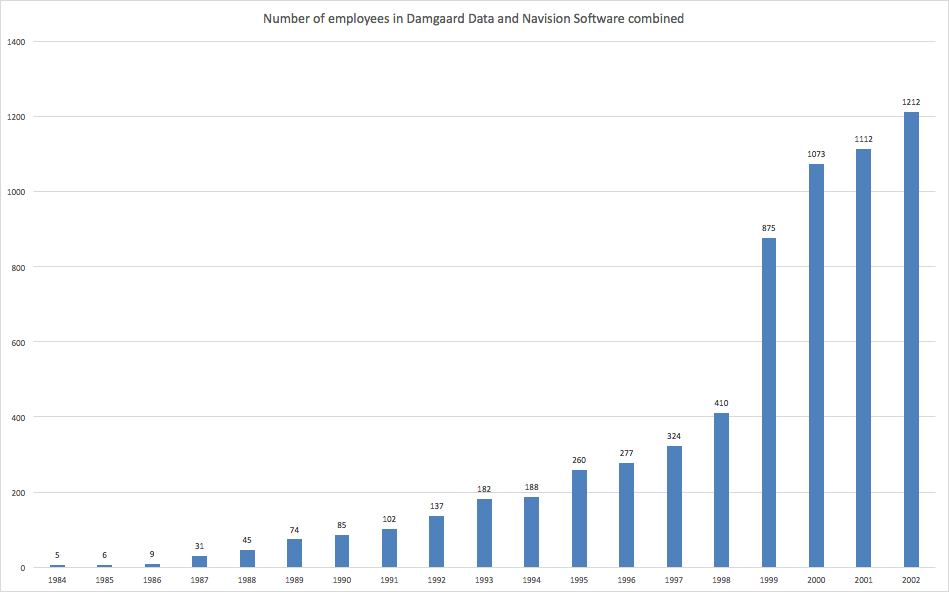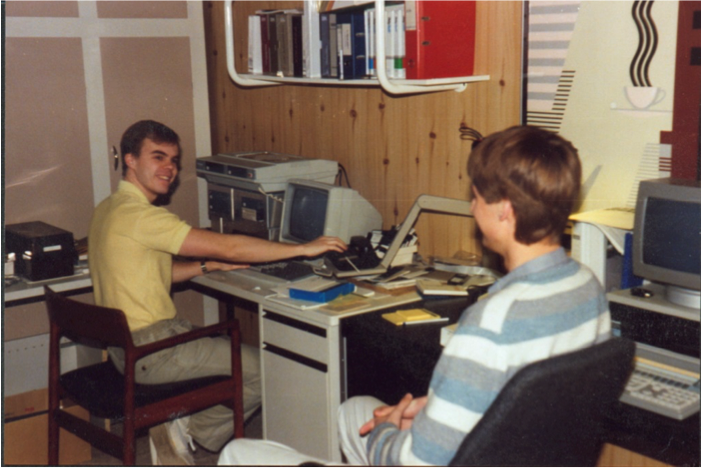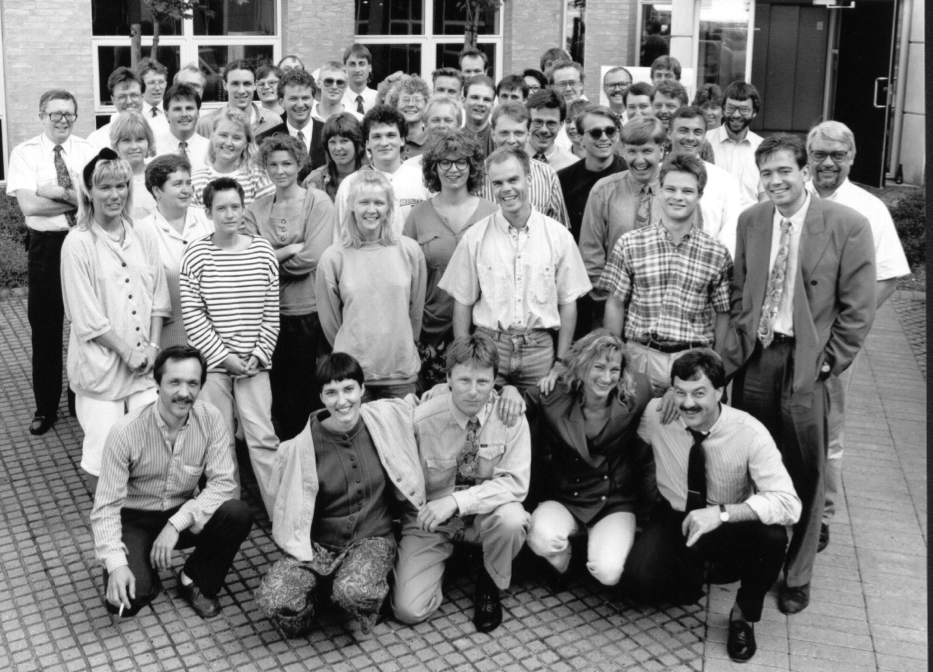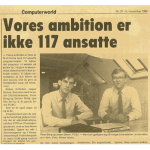Damgaard Data and Navision Software: Where Did the Employees Come From?
 When you read the book 5,460 Miles from Silicon Valley, you may notice that most of the actors did not find their way to either Damgaard Data or Navision Software by applying for a vacant job position.
When you read the book 5,460 Miles from Silicon Valley, you may notice that most of the actors did not find their way to either Damgaard Data or Navision Software by applying for a vacant job position.
How then did they get a job with one of these two successful Danish software companies?
From 0 to 1,200 employees over 18 years
The chart below shows the total number of employees (converted to full-time equivalents) in Damgaard Data and Navision Software (1984 – 1999) and in Navision (2000-2002) according to the annual accounts submitted to the Danish Commerce and Industry Agency.
 When Navision (the company that emerged after the merger of Damgaard Data and Navision Software in 2000) was sold to Microsoft in 2002, the company employed a little over 1,200 people. During the 18 years that passed since the two companies were startups, with only the owners as the workforce, there had been somewhere between 1,500 and 2,000 employees through the doors. Let’s just suppose the figure was 1,800, equivalent to 100 recruits each year or two new employees each week for 18 consecutive years (the big jump in 1999 was due to Damgaard Data’s divorce from IBM and Navision Software’s acquisition of its own distributors).
When Navision (the company that emerged after the merger of Damgaard Data and Navision Software in 2000) was sold to Microsoft in 2002, the company employed a little over 1,200 people. During the 18 years that passed since the two companies were startups, with only the owners as the workforce, there had been somewhere between 1,500 and 2,000 employees through the doors. Let’s just suppose the figure was 1,800, equivalent to 100 recruits each year or two new employees each week for 18 consecutive years (the big jump in 1999 was due to Damgaard Data’s divorce from IBM and Navision Software’s acquisition of its own distributors).
Where did the employees come from?
 As described in the book, the first appointments at Damgaard Data came via the owners’ social network and from unsolicited applications. If we disregard the two employees who came through the government’s Employment Program, then employee number one (Morten Gregersen) came from the network, while number two (Jens Svanholdt) came via an unsolicited application!
As described in the book, the first appointments at Damgaard Data came via the owners’ social network and from unsolicited applications. If we disregard the two employees who came through the government’s Employment Program, then employee number one (Morten Gregersen) came from the network, while number two (Jens Svanholdt) came via an unsolicited application!
(The picture shows Morten Gregersen (t.v.) and Jens Svanholdt in the basement under Erik and Preben Damgaard’s parents’ semidetached in Bagsværd in 1986.)
As the company established its name in the industry, both the firm’s social network and the volume of unsolicited applications grew and continued to be the main supplier of new employees. Only when there were no qualified candidates in the bundle of unsolicited applications or among the recommendations from the social network did the company turn to new sources.
Unsolicited applications
During my research for the book, I started all interviews by asking how the interviewee came to Damgaard Data and Navision Software. Even though my own employment at Damgaard Data at the end of 1997 (see the book page 471) came through an unsolicited application, I was nevertheless surprised by how many people had not been employed by applying for a vacant job position.
Damgaard Data took unsolicited applications very seriously (Navision Software probably did too, but I have not studied them so thoroughly). When a dedicated HR function was created in Damgaard Data, unsolicited applications were systematically read and distributed to the relevant departments.
Do you know someone or do you know someone who knows someone?
Damgaard Data soon became a decentralized organization, where managers had free rein to choose their staff, and of course, they often turned to people they already knew.
When Preben Damgaard needed to fill the key position of VP for sales and marketing in 1994, it was again his social network that came into play. He was reluctant to consider candidates that he did not know. That’s why he made a great effort to convince his favorite candidate, Per Pedersen, to take the job. It did not go as planned, and Per declined. Still reluctant to invite fresh candidates, Preben Damgaard took his time considering his options, which ensured that the position was still available when Per suddenly changed his mind. The whole story is laid out in chapter 14 and besides being quite funny, it is certainly also instructive.
Headhunting
 When key positions were to be filled, and no suitable candidates could be found among the unsolicited applications, and from the social network, positions were rarely posted publicly. Instead, the company engaged headhunters to find suitable candidates.
When key positions were to be filled, and no suitable candidates could be found among the unsolicited applications, and from the social network, positions were rarely posted publicly. Instead, the company engaged headhunters to find suitable candidates.
Many perceive headhunters as an expensive solution for recruitment, but Damgaard Data regarded it as an investment. When it came to key positions (salespeople and senior executives), the cost of a misappropriation outweighed the price that the headhunter asked.
The company wanted to find candidates that matched the job profile, and who may not have considered that time ripe for a change. By posting the vacancy and asking for applications, there was no guarantee that the candidates matched the profile. And the temptation to hire the best (among the possible) and not the right one was often too great when the need for filling a job position was urgent (and when was that not the case?).
Any new employee poses a potential risk
 For Damgaard Data and Navision Software, the employees were the vital resource. The products, the business model, and the operation were the results of brain activity only. The quality of all functions in the companies was directly related to the quality of the employees and to the culture that the leaders created and maintained. Adding a new employee who could work and grow in cooperation with his colleagues was of huge value. If the employee failed, the alternative costs were many times higher both for the company and for the new employee who had to find another job.
For Damgaard Data and Navision Software, the employees were the vital resource. The products, the business model, and the operation were the results of brain activity only. The quality of all functions in the companies was directly related to the quality of the employees and to the culture that the leaders created and maintained. Adding a new employee who could work and grow in cooperation with his colleagues was of huge value. If the employee failed, the alternative costs were many times higher both for the company and for the new employee who had to find another job.
The above is the primary explanation for why Damgaard Data chose the open job post as a last resort. As a bonus, the time spent and the hassle associated with hiring unsolicited applicants, recommended candidates and head-hunted candidates were far less than managing applications from open job listings. For companies in fast growth, this is crucial.
Hire slowly
 Hiring without posting the vacancies publicly is not equivalent to a sloppy recruitment process. When I submitted my unsolicited application, I still had to go through a series of interviews and tests that all candidates had to pass irrespective of where they came from. And before making the final decision, reference checks were made with persons that I had not suggested. It was an exhaustive screening process. Fortunately, I slipped through the eye of the needle and got one of the most exciting jobs I’ve ever had (it was also my last).
Hiring without posting the vacancies publicly is not equivalent to a sloppy recruitment process. When I submitted my unsolicited application, I still had to go through a series of interviews and tests that all candidates had to pass irrespective of where they came from. And before making the final decision, reference checks were made with persons that I had not suggested. It was an exhaustive screening process. Fortunately, I slipped through the eye of the needle and got one of the most exciting jobs I’ve ever had (it was also my last).
(The picture shows my colleague Lars Damsgaard Andersen from Navision Software (PC&C GmbH) to the left and me to the right (Damgard GmbH). Navision Software had built an impressive business in Germany, while Damgaard Data, due to the unsuccessful cooperation with IBM and a complicated product shift in 1998, lagged behind).
What is the moral of this story?
There are many lessons to be learned from the story about Damgaard Data and Navision Software, and when it comes to recruitment here are the most important:
- Companies should take unsolicited applications seriously
- And they should utilize the social network of their current employees actively
- Headhunting is an investment and not a cost
- If you are looking for a job, then send unsolicited, yet targeted applications
- Even when you’re happily employed, you must expand and nurture your network
- If you are applying for a publicly listed job, you will have the most competitors
Click for more information on the book








